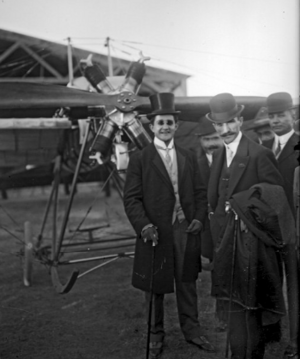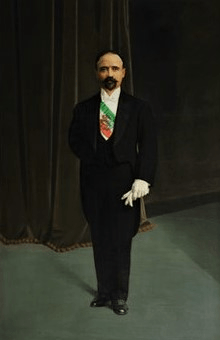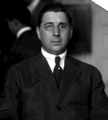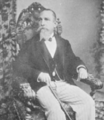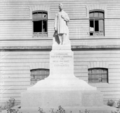José María Pino Suárez facts for kids
Quick facts for kids
José Maria Pino Suárez
|
|
|---|---|
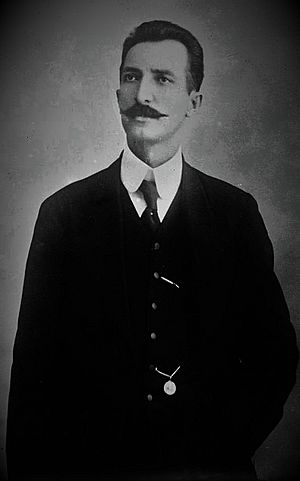 |
|
| 7th Vice President of Mexico | |
| In office 6 November 1911 – 19 February 1913 |
|
| President | Francisco Madero |
| Preceded by | Abraham González |
| Succeeded by | office abolished |
| Secretary of Education | |
| In office 26 February 1912 – 19 February 1913 |
|
| President | Francisco Madero |
| Preceded by | Miguel Diaz Lombardo |
| Succeeded by | Jorge Vera Estañol |
| President of the Senate | |
| In office 6 November 1911 – 26 February 1912 |
|
| President | Francisco Madero |
| Governor of Yucatán | |
| In office 8 October 1911 – 11 November 1911 |
|
| Preceded by | Jesus L Gonzalez |
| Succeeded by | Nicolás Camára Vales |
| Governor of Yucatán (Interim) |
|
| In office 6 June 1911 – 8 August 1911 |
|
| Preceded by | Luis del Carmen Curiel |
| Succeeded by | Jesus L González |
| Secretary of Justice (Provisional) |
|
| In office 5 October 1910 – 25 May 1911 |
|
| President | Francisco Madero Provisional |
| Personal details | |
| Born | 8 September 1869 Tenosique, Tabasco, Mexico |
| Died | 22 February 1913 (aged 43) Mexico City, Mexico |
| Resting place | Panteón de Dolores |
| Political party | Progressive Constitutionalist Party |
| Spouse | María Cámara Vales |
| Children | 6 |
| Parents | José María Pino Salvatiel (father) Josefa Suárez Abreu (mother) |
| Relatives | Pino Cámara Family Pedro Sáinz de Baranda y Borreiro (great-grandmother) Joaquín Baranda (great-uncle) Ismael Moreno Pino (grandson) |
| Alma mater | Colegio de San Ildefonso Instituto Literario de Yucatán |
| Profession | Lawyer newspaper proprietor politician poet |
| Awards | Belisario Domínguez Medal of Honor of the Mexican Senate |
José María Pino Suárez (born September 8, 1869 – died February 22, 1913) was an important Mexican politician, lawyer, and journalist. He played a key role in the Mexican Revolution. He served as the 7th and last Vice President of Mexico from 1911 until he was killed in 1913. This happened during a difficult time known as the Ten Tragic Days. People remember him and President Francisco I. Madero as champions of democracy and people who fought for social justice in Mexico.
Contents
Early Life and Education
José María Pino Suárez was born in Tenosique, Tabasco. His family was very well-known in Mérida. His great-grandfather, Pedro Sáinz de Baranda y Borreiro, was a hero of the Mexican War of Independence.
His Family Background
Pino Suárez was the oldest son of José María Pino Salvatiel, a businessman, and Josefa Suarez. Both his parents were from Mérida. His mother passed away shortly after he was born. He had a younger brother, Néstor Pino Suárez, who was a colonel. Néstor was badly wounded in a battle in 1912.
His great-grandfather, Pedro Sáinz de Baranda y Borreiro, was a naval officer and industrialist. He fought in the Mexican War of Independence. He also helped create the Mexican Navy. Pedro Sainz de Baranda captured the Fort of San Juan de Ulúa, which was the last Spanish stronghold in Mexico. He is also known for bringing the Industrial Revolution to Mexico. He founded the first textile factory in the country that used steam power.
Pino Suárez's great-uncles were Joaquín Baranda and Pedro Baranda. Joaquín was a powerful government minister for many years. He helped found the Public Prosecutor's Office. Pedro Baranda was a General who fought for liberal causes. He also helped create the states of Campeche and Morelos.
School Days
When Pino Suárez was a teenager, he went to school in Mérida. He attended the famous Colegio de San Ildefonso, which was run by Jesuits. He learned to speak French and English fluently there. In 1894, he earned his law degree from Instituto Literario de Yucatán.
Family Life
In 1896, José María Pino Suárez married María Cámara Vales. She was the oldest daughter of Raymundo Cámara Luján, a rich businessman. Her family was very powerful in Yucatán. María's brothers, Nicolás Camára Vales and Alfredo Pino Cámara, also became governors.
José and María had six children: Maria, Alfredo, José, Aída, Hortensia, and Cordelia. When Pino Suárez died in 1913, he was 43 years old. His oldest daughter, Maria, was 14, and his youngest, Cordelia, was not yet one year old.
His two sons, Alfredo and José, became successful lawyers like their father. Alfredo Pino Cámara became a judge in the Supreme Court. His grandson, Ismael Moreno Pino, became a diplomat. He served as an ambassador to many countries and the United Nations. He helped negotiate the Treaty of Tlatelolco, which aimed to remove nuclear weapons from Latin America.
Starting His Career
Lawyer and Businessman
After getting married, Pino Suárez and his wife moved to Mexico City. There, he started a law firm with his uncle, Joaquín Demetrio Casasús.
Around 1899, he returned to Mérida. He started working with his father-in-law, Raymundo Cámara Luján, in business. His father-in-law's company exported a lot of henequen, a fiber used for ropes. This business was very profitable.
At this time, Mérida was a very rich city because of the henequen boom. However, a small group of families controlled most of this wealth. There was a big rivalry between different business groups. One powerful figure was Olegario Molina, who was also the Governor of Yucatán. Molina tried to control the entire henequen industry.
After a financial crisis in 1907, many businesses struggled. Molina's rivals lost a lot of money, which made Molina even more powerful. These events made Pino Suárez want to get involved in politics.
A Poet and Writer
In his free time, Pino Suárez was also a talented poet. He published two books of poems: Melancolias (1896) and Procelarias (1903). He also wrote the introduction for a friend's book. He was working on a third book of poems called Constellations, but it was never published.
Starting a Newspaper
In 1904, Pino Suárez used his money to start a newspaper called El Peninsular. He wanted to use the newspaper to criticize Olegario Molina's control over the henequen industry.
El Peninsular quickly became popular. It was known for its modern printing and its coverage of national and international news. Pino Suárez wrote articles that showed how indigenous Maya and Yaqui workers were being treated unfairly, almost like slaves. This made some powerful families angry. They tried to stop the newspaper by making advertisers and readers pull their support. Pino Suárez had to sell El Peninsular. This experience made him want to pursue a career in politics to defend freedom of speech.
Entering Politics
Joining the Revolution
In 1908, Francisco I. Madero published a book called The Presidential Succession in 1910. This book argued for a change from the military rule of Porfirio Díaz to a liberal democracy. Madero's supporters were called Maderistas because they were against presidents being reelected.
Pino Suárez had stopped being involved in public life after his newspaper was shut down. He read Madero's book and was very excited. In 1909, he met Madero in Yucatán. They quickly became good friends.
Pino Suárez supported Madero's cause. He started the Anti-Reelectionist Club in Mérida. This club supported free and fair elections.
The Mexican Revolution Begins

In June 1910, Madero was campaigning for president. The government arrested him, but he later escaped from prison. From exile in Texas, Madero issued the Plan of San Luis Potosí. This plan said that the 1910 elections were unfair. It called for new democratic elections and for people to take up arms against the government. The plan also asked for land to be returned to farmers and for an eight-hour workday. This plan helped start the Mexican Revolution.
Pino Suárez helped organize the revolution in southeastern Mexico. He was forced to leave the country and joined Madero in Texas. Madero formed a temporary government and made Pino Suárez his Secretary of Justice.
In May 1911, the revolutionary forces won a big battle against the federal army. Pino Suárez represented Madero in talks that led to the Treaty of Ciudad Juárez. This treaty ended the rule of Porfirio Díaz after 30 years.
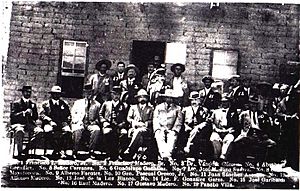
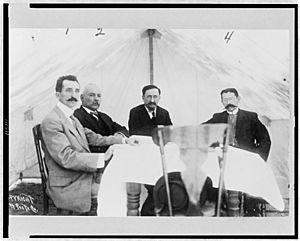
Becoming Governor of Yucatán
After the revolution succeeded, Pino Suárez was appointed temporary governor of Yucatán. His main job was to call for new state elections. To avoid influencing the elections, he stepped down as temporary governor. He then ran for the position of constitutional governor.
Pino Suárez won the election. He managed to get the support of many powerful landowning families for the revolutionary cause. During his short time as governor, Pino Suárez worked to reform the Penal Code. This code had previously limited basic rights.
Becoming Vice President
1911 Presidential Elections
In July 1911, Madero created the Progressive Constitutionalist Party. Madero was chosen as the presidential candidate. For vice president, Pino Suárez competed against several others. Madero supported Pino Suárez.
Pino Suárez won the vote for vice president. However, some people were not happy with the result. Francisco Vázquez Gómez, who lost, decided to run as an independent candidate.

On October 1, 1911, the main elections were held. Madero won the presidency easily. The real competition was for vice president. Pino Suárez won with 63.90% of the popular vote. On November 2, the Congress officially declared Madero and Pino Suárez the winners. They were set to govern for five years.
Vice President and Education Secretary
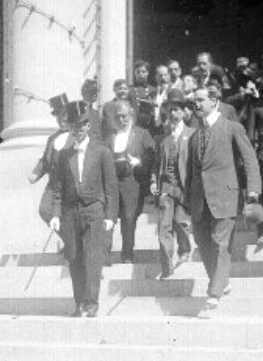
Pino Suárez arrived in Mexico City on November 18, 1911. On November 23, he took his oath of office in the Chamber of Deputies. He was very emotional during the ceremony. President Madero welcomed him, saying that Pino Suárez's election was a guarantee for the future of Mexico.
Soon after Pino Suárez took office, Emiliano Zapata, another revolutionary leader, published the Plan of Ayala. This plan criticized Madero's government and accused him of not fulfilling his promises.
In Madero's first government, Pino Suárez did not hold a ministerial position. However, his political influence grew significantly when Madero formed his second government.
On February 26, 1912, Pino Suárez was appointed to lead the Ministry of Education and Fine Arts. This was a very important role because education was a key part of Madero's revolution. Madero wanted to spread education beyond just the wealthy elite. Pino Suárez focused on elementary and popular education. He also wanted to change the national curriculum to be more humanistic.
Within the government, Pino Suárez led a group called the "renewal bloc." This group wanted to push for social reforms and progressive changes that Madero had promised. They had a majority in Congress but faced strong opposition from former supporters of the old regime. These opponents often attacked Pino Suárez personally.
Pino Suárez's reforms faced resistance, especially from the National School of Jurisprudence. This led to the creation of the Escuela Libre de Derecho, a private law school. Many of Pino Suárez's unfinished education reforms were later put into action by José Vasconcelos in the 1920s.
The Ten Tragic Days
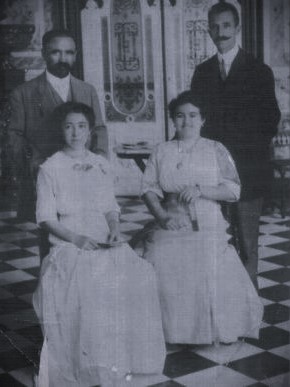
Madero's government faced many rebellions. In February 1913, a military coup took place. This event is known as the Ten Tragic Days.
On February 9, 1913, the coup began. Pino Suárez quickly informed the Governor of the Federal District about the uprising. Pino Suárez and the governor went to the National Palace, which was already under attack.
Later that day, Pino Suárez and the governor went to Chapultepec Castle, where President Madero was. They told Madero about the events in the city. The National Palace had been protected by General Lauro Villar Ochoa, who was loyal to Madero. General Villar was wounded, so Madero appointed General Victoriano Huerta to take his place. Huerta was put in charge of stopping the rebellion.
However, Victoriano Huerta was secretly working with the rebels. He pretended to be loyal but made sure his attacks on the rebel stronghold, La Ciudadela, caused minimal damage. This made Madero's government look weak. Madero's brother, Gustavo, suspected Huerta's betrayal. On February 17, Gustavo Madero arrested Huerta and accused him of treason. But President Madero, making a big mistake, decided to free Huerta. He gave Huerta 24 hours to capture La Ciudadela.
The next day, February 18, rebel troops broke into the National Palace during a cabinet meeting. They arrested President Madero, Vice President Pino Suárez, and other officials. Gustavo Madero was also arrested and later killed.
Pedro Lascuráin, the Foreign Secretary, acted as a go-between for Madero and Huerta. Huerta offered Madero and Pino Suárez safe passage out of the country if they resigned. Madero and Pino Suárez agreed, but they had conditions. They wanted to be safely on a Cuban warship with their families before their resignations were made public. Pino Suárez insisted that the resignation documents state they were "compelled by circumstances."
However, Lascuráin immediately took the resignations to Congress. Congress accepted them, believing it would save Madero and Pino Suárez's lives. Lascuráin was sworn in as interim President for 45 minutes. During this time, he appointed Victoriano Huerta as Minister of the Interior. Then, Lascuráin resigned, making Huerta the next in line for the presidency.
Despite efforts from diplomats and their families, Huerta's government never allowed Madero and Pino Suárez to go into exile.
His Tragic Death
On the night of February 22, Madero and Pino Suárez were taken from the National Palace. They were supposedly being moved to Lecumberri Prison.
When they arrived at the prison, the cars drove past the main entrance to a secluded area. There, a corporal named Francisco Cárdenas shot Madero in the head, killing him instantly. Lieutenant Rafael Pimienta then shot Pino Suárez.
The assassinations were ordered by General Huerta and his cabinet. The Huerta government claimed that Madero and Pino Suárez were shot while trying to escape during a rescue attempt by their supporters.
Remembering Pino Suárez
Maria Cámara, Pino Suárez's widow, fled Mexico City after his death. In 1969, she received the Belisario Domínguez Medal of Honor from the Mexican Senate. This is the highest award Mexico gives to its citizens.
In 1986, President Miguel de la Madrid ordered Pino Suárez's remains to be moved to the Rotonda de las Personas Ilustres. This is a special place that honors important Mexicans.
In 1915, Pino Suárez's birthplace in Tabasco was renamed Tenosique de Pino Suárez. A statue was built in his honor in Villahermosa, the state capital. His name is also written in golden letters in the Tabasco State Congress assembly hall. The public library there is also named after him.
Many cities across Mexico have streets named after him, especially near city centers. In 1914, Pancho Villa ordered that a street leading from the Zócalo in historic center of Mexico City be named Pino Suárez Avenue. It is still a very important street today. The Supreme Court of Justice building is on this street.
Metro Pino Suárez, one of the busiest stations in the Mexico City Metro, is also named after him.
In 2010, for the 100th anniversary of the Mexican Revolution, the Central Bank of Mexico made a special five-peso coin with José María Pino Suárez's portrait on it.
Images for kids
-
Pedro Sáinz de Baranda y Borreiro, hero of the Mexican Wars of Independence, was his great-grandfather.
-
Pino Suárez was inspired by Carlos Peón, a former Governor of Yucatan (1894–97), who believed in classical liberalism.
-
President Madero and Vice-president Pino Suárez receiving suffragettes at the Chapultepec Castle, then the Presidential Residence.
-
The Madero and Pino-Cámara families photographed at the Chapultepec Castle, then the presidential residence.
-
Madero and Pino Suárez portrayed with the Porfirista Army which eventually would betray them. To Madero's left is Pedro Lascurain, the Foreign Secretary.
-
Pino Suárez Public library in Villahermosa, Tabasco.
See also
 In Spanish: José María Pino Suárez para niños
In Spanish: José María Pino Suárez para niños
- Liberalism in Mexico
- Mexican Revolution
- List of Vice presidents of Mexico
- Ten Tragic Days
| Political offices | ||
|---|---|---|
| Preceded by Ramón Corral |
Vice President of Mexico 1911–1913 |
Succeeded by Office abolished |



